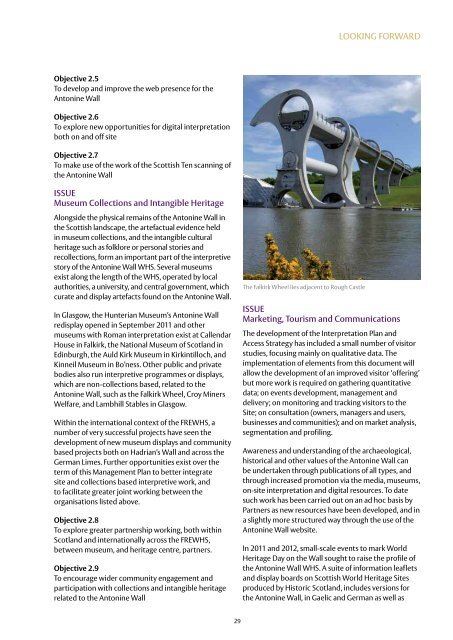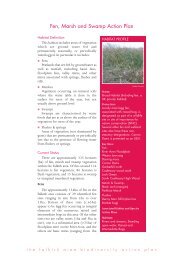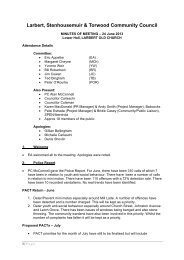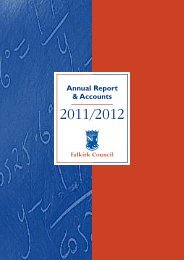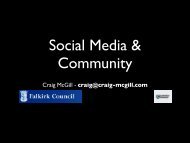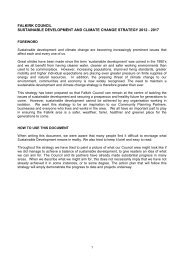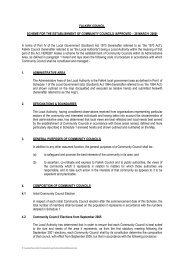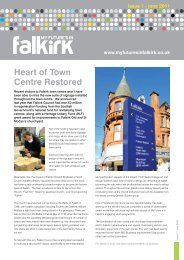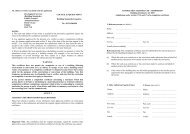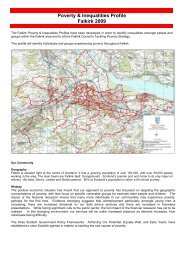The AnTonine WAll - Falkirk Council
The AnTonine WAll - Falkirk Council
The AnTonine WAll - Falkirk Council
You also want an ePaper? Increase the reach of your titles
YUMPU automatically turns print PDFs into web optimized ePapers that Google loves.
Objective 2.5<br />
To develop and improve the web presence for the<br />
Antonine Wall<br />
Objective 2.6<br />
To explore new opportunities for digital interpretation<br />
both on and off site<br />
Objective 2.7<br />
To make use of the work of the Scottish Ten scanning of<br />
the Antonine Wall<br />
issue<br />
museum collections and intangible heritage<br />
Alongside the physical remains of the Antonine Wall in<br />
the Scottish landscape, the artefactual evidence held<br />
in museum collections, and the intangible cultural<br />
heritage such as folklore or personal stories and<br />
recollections, form an important part of the interpretive<br />
story of the Antonine Wall WHS. Several museums<br />
exist along the length of the WHS, operated by local<br />
authorities, a university, and central government, which<br />
curate and display artefacts found on the Antonine Wall.<br />
In Glasgow, the Hunterian Museum’s Antonine Wall<br />
redisplay opened in September 2011 and other<br />
museums with Roman interpretation exist at Callendar<br />
House in <strong>Falkirk</strong>, the National Museum of Scotland in<br />
Edinburgh, the Auld Kirk Museum in Kirkintilloch, and<br />
Kinneil Museum in Bo’ness. Other public and private<br />
bodies also run interpretive programmes or displays,<br />
which are non-collections based, related to the<br />
Antonine Wall, such as the <strong>Falkirk</strong> Wheel, Croy Miners<br />
Welfare, and Lambhill Stables in Glasgow.<br />
Within the international context of the FREWHS, a<br />
number of very successful projects have seen the<br />
development of new museum displays and community<br />
based projects both on Hadrian’s Wall and across the<br />
German Limes. Further opportunities exist over the<br />
term of this Management Plan to better integrate<br />
site and collections based interpretive work, and<br />
to facilitate greater joint working between the<br />
organisations listed above.<br />
Objective 2.8<br />
To explore greater partnership working, both within<br />
Scotland and internationally across the FREWHS,<br />
between museum, and heritage centre, partners.<br />
Objective 2.9<br />
To encourage wider community engagement and<br />
participation with collections and intangible heritage<br />
related to the Antonine Wall<br />
29<br />
<strong>The</strong> <strong>Falkirk</strong> Wheel lies adjacent to Rough Castle<br />
looking forward<br />
issue<br />
marketing, tourism and communications<br />
<strong>The</strong> development of the Interpretation Plan and<br />
Access Strategy has included a small number of visitor<br />
studies, focusing mainly on qualitative data. <strong>The</strong><br />
implementation of elements from this document will<br />
allow the development of an improved visitor ‘offering’<br />
but more work is required on gathering quantitative<br />
data; on events development, management and<br />
delivery; on monitoring and tracking visitors to the<br />
Site; on consultation (owners, managers and users,<br />
businesses and communities); and on market analysis,<br />
segmentation and profiling.<br />
Awareness and understanding of the archaeological,<br />
historical and other values of the Antonine Wall can<br />
be undertaken through publications of all types, and<br />
through increased promotion via the media, museums,<br />
on-site interpretation and digital resources. To date<br />
such work has been carried out on an ad hoc basis by<br />
Partners as new resources have been developed, and in<br />
a slightly more structured way through the use of the<br />
Antonine Wall website.<br />
In 2011 and 2012, small-scale events to mark World<br />
Heritage Day on the Wall sought to raise the profile of<br />
the Antonine Wall WHS. A suite of information leaflets<br />
and display boards on Scottish World Heritage Sites<br />
produced by Historic Scotland, includes versions for<br />
the Antonine Wall, in Gaelic and German as well as


